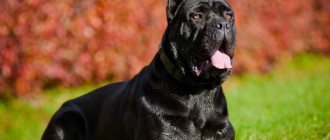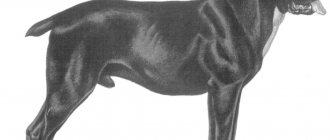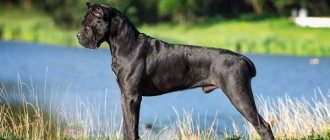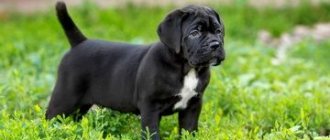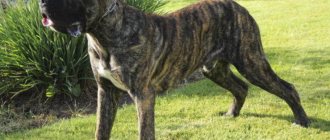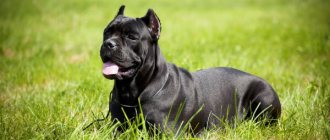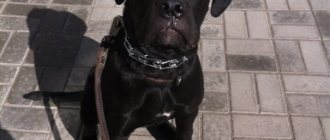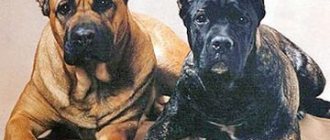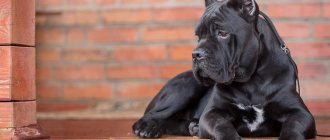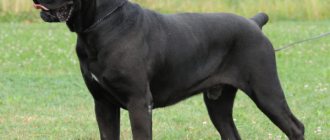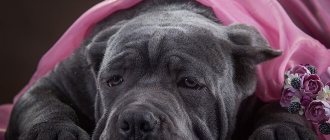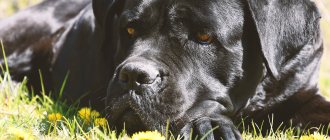History of the breed
The ancestors of the mastiff are considered to be Molossian dogs, which were once raised in Ancient Rome. They accompanied legionnaires on campaigns and protected homes from robbers. It was this breed that was used in gladiator fights, because Cane Corsos are very strong animals.
And at the same time, since ancient times, dogs have played with children and helped their owner in the hunt. Even ancient figurines of this breed of dog have been found. The Italian Mastiff became widely known after the publication of the researcher Breber. He studied Italian villages, where the Cane Corso was simply an irreplaceable assistant.
Historical reference
The Cane Corso dog breed is undeniably the heir to the ancient Molossians, to be more precise, the ancient Tibetan Great Danes. Modern Tibetan Mastiffs (Mastiffs) are a breed that has experienced “reincarnation” more than once, but their appearance even today makes people shiver with goosebumps. The first Tibetan Dogo appeared on the Eurasian mainland 1000 years BC, or so the story goes. An aggressive giant trained to catch people was presented as a gift to the ruler of China. Having spread throughout Europe and Asia, Molossians became the ancestors of many modern breeds.
New breeds of dogs have been developed over the centuries to suit the needs of specific territories. The descendants of the Molossians who came to the Roman Empire were also used for their intended purpose - arena battles, military campaigns, and territory protection. Mentions of giants called Corso are found in hunting and baiting chronicles dating back to 1400–1500. It should be noted that in some territories, four-legged animals were used as flock guards. Chroniclers characterize the ancient Cane Corsos as strong, tireless, fearless and loyal dogs.
It is ethical to count the official history of the breed from the times of the prosperity of the Roman Empire. It is this time period that is replete with historical monuments depicting the early Cane Corso in hunting, arenas and fighting. The development of these powerful dogs is continuously intertwined with the history of Italy. Even without delving into cynology references, historical sources tell of giant dogs dressed in armor and lined up in ranks. About dog fights and fights with wild animals. About evil four-legged slave overseers and palace guards.
The Roman Empire fell shortly before the fifth hundred years of our era and a feudal system reigned in Italy. This stage should be considered as a separate step in the formation of the breed. The export of dogs atypical for Italy, for example, Celtic Greyhounds, led to changes and the creation of new progenitors of the breed. Against the backdrop of changes, the already established Italian Cane Corso was widespread throughout the country, especially in the South, where hunting for large wild animals flourished.
With the new regime, dogs began to be used in a new position - guarding farms in the off-season. After the harvest, the land was left under the responsibility of one person and several Cane Corsos. It should be noted that the breed was used for quite a long time as a cattle driver, which also limited contact with the outside world. The echoes of such “professions” were unshakable loyalty to one person - the owner.
The versatile use of Molossians has led to the versatility of modern Cane Corsos. In addition, such powerful dogs were highly valued, which led to a global expansion of the high-quality gene pool. However, history cannot be a straight line; there are always peaks and valleys. The downfall of the breed was the Second World War, the general crisis and the collapse of the economies of many countries. Lack of food and the extermination of “non-front” dogs brought the Cane Corso to the point of extinction and the end of these giants was too close to prevent it.
The revival of the ancient giants is an example of the titanic loyalty and perseverance of one man - Mr. Giovanni Bonatti Nizzoli. Being an educated person, versed in history and facts, the man believed in a miracle and raised the wave of the revival of the Cane Corso. 10 years after the idea was conceived, in 1983, a group of researchers (who were also the founders of the Cane Corso lovers club) literally combed the southern regions of Italy in search of surviving representatives of the breed. By 1987, the first official breed standard was drawn up. The description not only revealed in detail every feature of the ancient giants, but also clearly indicated the differences between the Cane Corso and Mastiffs and Neapolitan Mastiffs in particular.
Before the official opening of breeding registration (1994), more than 500 producers and 700 puppies received positive expert assessment and recognition. Immediately after the recognition of the breed by the Italian Canine Society, the number of dogs exceeded the three thousandth threshold. In 1996, the best producer of Italy with honor defended the reputation of the Cane Corso at the FCI (International Cynological Association) exhibition.
Mastiff character
The dog's menacing appearance evokes every respect. She is completely devoted to her family. If necessary, the animal will not hesitate to sacrifice its life to save its owners. Such exceptional devotion is not often found. The Italian Mastiff is highly trainable. But still, his main task is security. And at the same time, such a strong dog has a gentle soul; she greatly experiences separation from her owner.
The Cane Corso is a large animal, so it will be more comfortable for him to live in a private home. For an apartment it is better to take smaller breeds.
The Italian Mastiff, whose character is very calm, sometimes likes to play pranks. For example, slightly spoil the flowers in the flowerbed or dig a hole in the middle of the garden. And of course, like all dogs, the mastiff loves to chew on all sorts of objects. Therefore, you need to make sure that he has a sufficient number of different toys, otherwise he will go looking for new, interesting objects for fun.
The Italian Mastiff (photos are given in the article) is a calm and balanced dog. She is friendly with people she knows. But he is very wary of strangers. But at the same time, she will never show aggression without good reason.
Nutrition
When choosing between natural food and dry food, experienced owners often lean towards the second option, because Cane Corso dogs are prone to food allergies. The disadvantage of this solution is the high price of hypoallergenic feed. Pros - it’s easy to calculate the dosage; sometimes you can pamper your pet with canned food of the same brand.
Initially, you can try natural foods to check for allergies. Then you will have to spend a lot of time to create a complete and balanced diet. It is not compiled for life, but is constantly adjusted depending on the age and condition of the animal, its physical activity and even the season.
Cane Corso in the forest in autumn
New foods can be introduced to the puppy only two weeks after he has settled in the new home, and the frequency of feedings must initially be the same as at the previous place of residence. It is advisable to have equal intervals between feedings.
Cane Corso, as a fairly energetic and strong dog, needs a large amount of animal protein. It is found in meat, fish, eggs. Puppies can be fed boiled veal or rabbit.
If the animal is natural, then the menu must include porridges based on meat and other broths. For taste, you can season them with fresh herbs and vegetables. A variety of fruits and salads dressed with yogurt can serve as treats. Under no circumstances should you feed your Cane Corso pork, lard, bones, river fish, sweets, spices, or poultry skin.
Behavioral Characteristics of the Mastiff
The Cane Corso is a guard dog. Therefore, if a stranger invades the territory he protects, he will fulfill his duty. The Italian Mastiff is a powerful breed with a strong character, and therefore the dog can test the owner’s strength. You need to be able to become the boss. Each family member should be able to manage an animal.
Regular early training will help you set priorities correctly and show who is in charge in the family.
Otherwise, the Italian Mastiff is a calm, loyal dog that loves its loved ones. The animal follows its owner everywhere and can even sometimes be afraid of separation if left alone for a long time.
The Italian Cane Corso mastiff (photos presented) usually dominates its relatives. It may even behave aggressively with other dogs. On foreign territory, they, as a rule, will not run into a fight, but they will not leave it when provoked. In order for a dog to be socialized, it is necessary that even when it is a puppy it communicates with other dogs and people. This will help to properly shape her character.
Education and training
Raising a dog should begin from a very early puppyhood.
It is important to help the puppy learn about the world around him and perceive it correctly in different situations..
Already at this age, training goes in two directions - discipline and obedience, as well as professional, watchdog qualities. It is best to carry out education immediately with the involvement of a specialist.
A dog's normal character is formed in several ways . First of all, a good genetic code is ensured as a result of selection. One of the effective methods is imprinting.
It involves keeping the puppy with a trained mother for a long time. Through her example, he receives the necessary education. Another way is to socialize the dog.
Starting from 3-4 months of age, the puppy should have active contact with people and other animals.
Italian Mastiff: description of the breed
The Cane Corso is a large, athletic dog with short hair. She has an almost square skull. The dog's eyes are smart and expressive, its ears are drooping and set high. The animal has a muscular neck. The tail is usually docked at the fourth vertebra. However, in a number of countries (Germany, Finland, Sweden and others) docking has long been abandoned.
The color of mastiffs can be very different: gray, black, all shades of brindle, fawn. There may be a white tie around the neck.
The color of an animal's eyes depends on the color of its coat. The dog's height at the withers does not exceed seventy centimeters, and its weight ranges from forty-three to fifty kilograms. Females have more modest parameters (height - up to 58 cm, weight - up to 45 kg).
Unfortunately, the Italian mastiff cannot be classified as a long-liver. Their average lifespan ranges from five to ten years. Of course, this is not enough for such a strong and beautiful animal.
Caring for a Mastiff
An undeniable advantage in caring for the Italian Mastiff is the presence of short hair and a thin undercoat. The pet should be brushed with a massage mitt or rubber brush a couple of times a week. This procedure will help remove excess hair from the animal and activate blood circulation.
The Cane Corso does not have the characteristic unpleasant dog odor. But as for drooling, some people are concerned about this point. In this case, we can only advise you to always have a towel on hand.
You shouldn't bathe your dog too often. A couple of times a month is enough, it is better to do this as it gets dirty. As an option, you can consider dry cleaning using special shampoos. Pet stores now have a very large selection of such products.
When dry cleaning, after treatment the wool should be wiped with a terry towel. It is very important to keep an eye on your dog's ears. Make it a rule to look into them every week, checking for inflammation.
Healthy ears should not have brown discharge with an unpleasant odor. Dirt should be removed with cotton pads, but you should not go deep into the ear canal. You need to be very careful with your ears. If you notice that your dog is shaking its head, has an unpleasant odor, or has purulent discharge, then you urgently need to contact a veterinarian.
The mastiff's teeth also require care (to prevent tartar). To do this, the diet must contain solid food and tomatoes. There is even a treat for cleaning your teeth. But only a veterinarian can remove stones and plaque.
Once a month, you can sharpen your claws yourself at home using a special nail clipper.
You should check your mastiff's eyes regularly. In a healthy dog they are shiny and without any discharge. Soured eyes are washed with chamomile decoction.
Advantages and disadvantages
Among the positive qualities of the Cane Corso, the following characteristics stand out::
- attractive, stately appearance, prestige;
- watchdog abilities, selflessness in protecting the entire family and property;
- absolute devotion to the owner;
- love of children and ability to get along with other pets;
- ease of hair care;
- tendency to train.
When choosing this breed, you must also take into account the presence of some negative aspects.:
- significant size and strength require proper training;
- a tendency to lead, requiring certain strong-willed qualities and patience from the owner;
- need for long walks (at least 2 hours a day);
- a sufficiently large volume of the daily diet;
- drooling;
- tendency to articular dysplasia;
- high cost of puppies.
Despite the presence of disadvantages, the positive qualities of the breed outweigh, and the Cane Corso has gained wide popularity.
She began to be considered a fairly prestigious and fashionable dog.
What to feed your Cane Corso?
The Italian Mastiff can be fed with natural food or dry food, but certain rules must be followed:
- The diet must contain absolutely all the necessary substances for the healthy development of the dog (fats, proteins, carbohydrates, mineral components and, of course, vitamins).
- The dog should always have access to water.
- An active mastiff should not be fed earlier than two hours after a walk.
- When using natural food, you should also give your dog mineral supplements.
The food must be such that the following parameters are maintained:
- The daily protein intake is 220-270 grams.
- Fats – 50-70 grams.
- Carbohydrates – 450-470 grams.
- Fiber – 40 grams.
- At least one liter of water per day.
How to choose a puppy?
It is difficult to find a good quality dog. When purchasing a puppy, carefully study the pedigree. You definitely need to look at the baby's parents.
An Italian mastiff in St. Petersburg, for example, can cost from thirty-five thousand rubles and more. It all depends on the pedigree. A good puppy will cost much more.
As a watchman and guard, you will not find a better breed than the Italian Mastiff. The characteristics of the breed, however, are very general. You need to understand that each animal has its own temperament. To get a good dog, you need to regularly educate and train it. Then your pet will listen to you unquestioningly and love you. Don't forget to show him affection.
Before purchasing a puppy, you need to decide for what purpose you need it: for home and comfort or for exhibitions. In the first case, you can buy a cheaper animal from an advertisement.
But show-class dogs are quite expensive. And this needs to be understood. The puppy must have all the necessary pedigree documents, these are provided by the breeder or kennel.
The price for a show-class animal in some regions reaches seventy thousand. Much depends on the puppy's parents. If they have championship titles, then, of course, the baby also has valuable genes. Therefore the price will be appropriate.
If you just want to have a good friend and guard, then you should not chase titles and pedigree. Whatever animal you choose, it will require a lot of attention and care from you, but in return you and your family members will receive boundless love and devotion from the dog.
